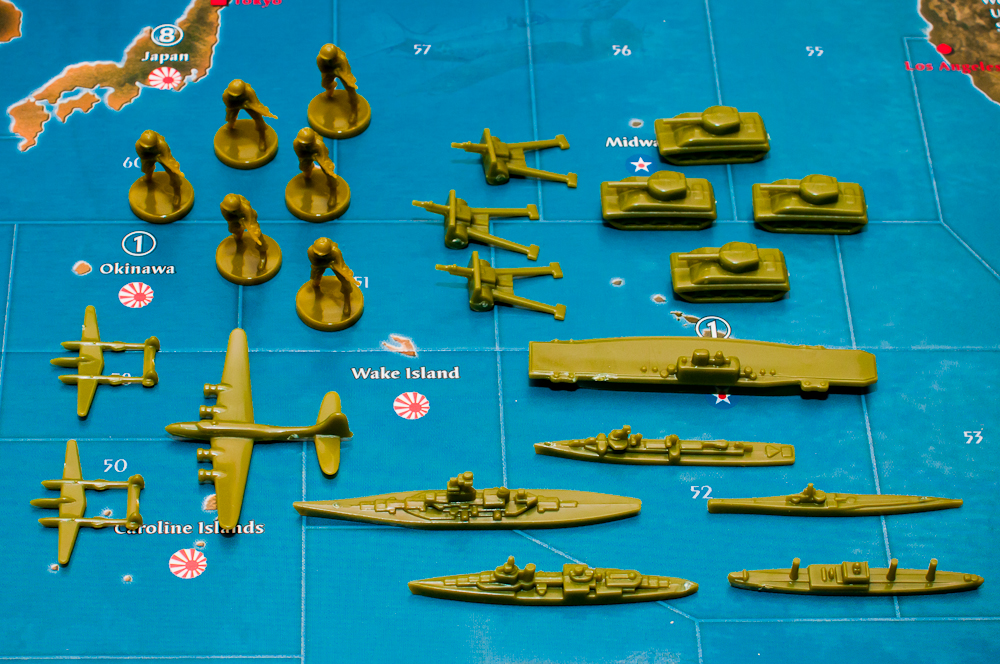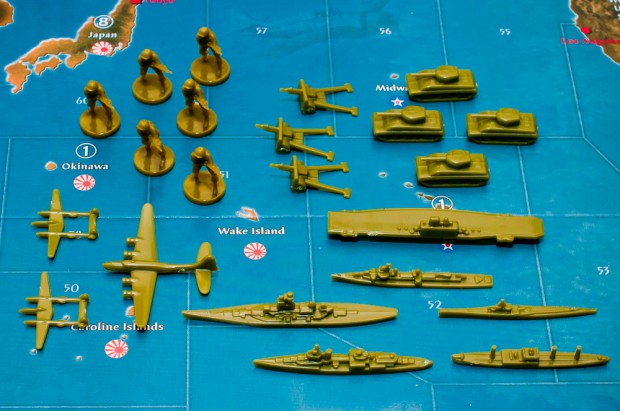DECLARATION OF PURPOSE
The intended purpose of this series of articles is the creation of a systematic and readily understandable approach to discussing tactics and strategy for Axis and Allies Spring 1942 edition.
Mysticism and vague references have no place in proper tactical and strategic discussion. For example, some players speak of mystical “surprise attacks”. But surprise attacks are not possible in Axis and Allies because there is no fog of war or misinformation capability. Vague references like “sealion” and “polar express” are not understood by some players, and worse, understood differently by different people. Even if you yourself understand exactly what you mean, if half the people you’re talking with think you’re talking about something even just a bit different, the discussion goes nowhere.
INTRODUCTION
Tactically, a player should understand which units are most effective in different situations and why, and know when and how to use those units. A player must be able to look at the board and assess the condition of the moment, and be able to determine which moves are “safe” and which are “unsafe”.
Strategically, a player should be able to assess the stage of development of both one’s own and the opponent’s plans. The player can therefore correctly identify whether an opportunity is fleeting or expanding, and act appropriately. In so doing, a player may determine that a tactically “safe” action is strategically unsafe, and may determine that tactically “unsafe” actions are the best strategic option.
This series of articles begins with unit properties, then moves on to calculation methods for assessing combat results, comments on probability, tactics, then strategy.
UNITS: COST EFFICIENCY PERCENTAGES FOR INFLICTING CASUALTIES
Each unit has a cost. Most have attack and defense values. A percentage has been caluclated here for each unit’s attack or defense by dividing the unit’s attack or defense by its cost. For example, infantry attack at 1 and cost 3, 1 is divided by 3 to get an infantry attack of 33%. Similarly, infantry defend at 2 or less and cost 3, so 2 is divided by 3 to get an infantry defense of 67%. Higher percentages indicate higher cost efficiencies at inflicting casualties on an initial round of combat.
Infantry: Cost 3, attack 1, defense 2. Attack 33%. Defense 67%.
Artillery: Cost 4, attack 2, defense 2. Attack 50%. Defense 50%.
Tank: Cost 5, attack 3, defense 3. Attack 60%. Defense 60%. Moves two.
Antiaircraft gun: Cost 6. Special. Can prevent a tank from blitzing.
Industrial complex: Cost 15. Special. Can prevent a tank from blitzing.
Transport: Cost 7. Transports units. Noncombatant.
Submarine: Cost 6, attack 2, defense 1. Attack 33%. Defense 17%. Sub rules.
Destroyer: Cost 8, attack 2, defense 2. Attack 25%. Defense 25%. Hunts subs.
Cruiser: Cost 12, attack 3, defense 3. Attack 25%. Defense 25%. Support shot.
Battleship: Cost 20, attack 4, defense 4. Attack 20%. Defense 20%. Support shot, two hits.
Carrier: Cost 14, attack 1, defense 2. Attack 7%. Defense 14%. Can carry up to two fighters.
Fighter: Cost 10, attack 3, defense 4. Attack 30%. Defense 40%. Air unit, up to 2 can land on a friendly carrier.
Bomber: Cost 12, attack 4, defense 1. Attack 30%. Defense 8%. Air unit.
COMBINATIONS OF UNITS: COST EFFICIENCY PERCENTAGES FOR INFLICTING CASUALTIES
The percentages of the below listed combinations of units come from taking the respective sums of a unit combination’s cost, attack, and defense, and dividing. For example, an infantry-tank combination costs a total of 8 (3 for infantry 5 for tank), has a total attack of 4 (1 for infantry 3 for tank), and total defense of 5 (2 for infantry 3 for tank). 4 is divided by 8 to get an attack of 50%; 5 is divided by 8 to get a defense of 63%.
Infantry-artillery combination: Attack 57%. Defense 57%.
Infantry-tank combination: Attack 50%. Defense 63%.
Carrier-2 fighter combination: Attack 21%. Defense 29%.
THE OTHER HALF OF COMBAT: CHEAP COMBAT FODDER AND WITHSTANDING CASUALTIES
The ability of a group of units to withstand casualties is at least as important, if not more important, than its ability to inflict casualties.
We consider three cases, each with 30 IPCs of units attacking 30 IPCs of units. In the first case, 6 tanks attack 6 tanks. In the second case, half the IPCs of the attacking force are spent on infantry, with 5 infantry and 3 tanks attack 6 tanks. In the third case, all the IPCs of the attacking force are spent on infantry, with 10 infantry attacking 6 tanks. As listed above, the cost efficiencies of a tank on attack or defense are both 60%; cost efficiency of an infantry unit on attack is 33%.
CASE 1: 6 TANKS VS 6 TANKS
When 6 tanks attack 6 tanks, the attackers win about 50% of the time. This makes sense, because the attacking force and the defending force have the same statistics.
CASE 2: 5 INFANTRY 3 TANKS VS 6 TANKS
When 5 infantry 3 tanks attack 6 tanks, the attackers win about 65% of the time. How can this be? Infantry have an attack of 33%, which is much lower than the tank’s attack of 60%. Since the attacker is now spending half their IPCs on weak infantry instead of powerful tanks, why does the win percentage go up? Cheap infantry are removed as casualties first, preserving the more powerful tanks. Infantry are cheaper, so more infantry can be bought; the additional numbers mean the attacking force of infantry and tanks has more staying power in combat.
5 infantry 3 tanks have a combined attack value of 14 (5 infantry x hit on 1 or less) + (3 tanks x hit on 3 or less) = 5 + 9 = 14. Likewise, 6 tanks have a combined defense value of 18 (6 tanks x 3 or less). On the first round of combat, the attackers will inflict about 14/6 casualties on average (2 and 1/3 units) and suffer 18/6 (3 units) casualties in return. After the first round of combat, the most likely result is that three attacking infantry and two defending tanks will be destroyed. Although more attackers than defenders are destroyed (three infantry as opposed to two tanks), the cost to the defender is still a bit higher here because of the higher cost of each defending unit. (The attacker loses 3 infantry, or 9 IPCs worth of units, and the defender loses 2 tanks, or 10 IPCs worth of units.) A tank costs 166% as much as an infantry. That’s very expensive!
The second round of combat is 2 infantry 3 tanks attacking 4 tanks. The attackers now attack at 11, the defenders defend at 12. This round, the most likely result is that both attackers and defenders will lose 2 units. Again, the attacker loses cheap infantry while the defender loses expensive tanks; now the attacker loses 6 IPCs worth of units while the defender loses 10 IPCs.
The third round is 3 tanks attacking 2 tanks. From this point, the attacker clearly has the advantage.
CASE 3: 10 INFANTRY VS 6 TANKS
When 10 infantry attack 6 tanks, the attackers win about 40% of the time. Although there are a lot of infantry to soak up casualties, infantry still lack attack power.
MIXING ATTACK POWER AND ABILITY TO WITHSTAND CASUALTIES IS BEST
To recap, the attacking force with the most attacking power but the least ability to withstand casualties, and the attacking force with the least defensive power but the most ability to withstand casualties, both had a lower percentage of success than the attacking force that mixed attack power with the ability to withstand casualties.
Understanding what unit combinations have high winning percentages on attack and/or defense allows a player to plan effective unit purchases and movement. Ground campaigns are usually best with masses of infantry, a few support artillery, and a lot of tanks. Naval campaigns are usually best with carriers and fighters for defensive power, and cheap destroyers to soak up damage and to block enemy fleet movement.
IN OUR NEXT EXCITING EPISODE
Bunnies explains how combat results can be evaluated as a nice neat number, then explains how useless that number actually is. Then you get home and discover all your carrots are missing. Bad, bad bunnies.


